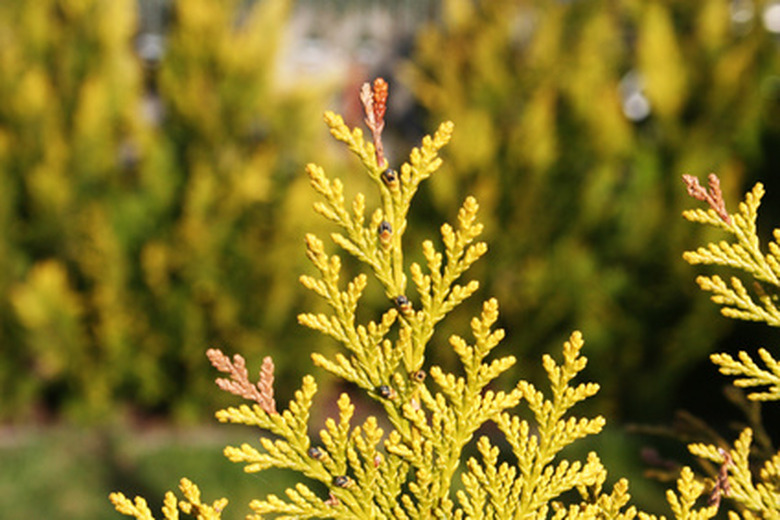Leyland Cypress Vs. White Cedar
Two evergreen conifer trees make exceptional hedges or screens for home landscapes. Leyland cypress grow quickly to 60 feet tall and 12 feet wide, needing pruning early in its life to contain it to shorter, more manageable heights. White cedar grows to 40 feet tall and 15 feet wide and handles annual shear-pruning nicely. Across the American South, canker continues to decimate Leyland cypress hedgerows.
Taxonomy
Both members of the cypress family (Cupressaceae), neither of these plants are closely related as they each belong to a separate genus, a botanical grouping of similar species. Leyland cypress (Cupressocyparis leylandii) is not a true cypress (Cupressus), and white cedar (Thuja occidentalis) is not a true cedar (Cedrus or Juniperus).
Origins
Leyland cypress resulted as a hybrid cross in the late 19th century in Wales by crossing Monterrey cypress (Cupressus macrocarpa) with Alaskan cedar (Chamaecyparis nootkatensis). Both parent species are native to western North America. White cedar, also known as American arborvitae, hails from the temperate woodland of eastern North America, roughly from Nova Scotia to Manitoba south to lower Michigan.
- Two evergreen conifer trees make exceptional hedges or screens for home landscapes.
- Leyland cypress grow quickly to 60 feet tall and 12 feet wide, needing pruning early in its life to contain it to shorter, more manageable heights.
Coldhardiness
The origins of both plants finds them better suited to regions based on their coldhardiness, or ability to survive annual winter minimum temperatures. Grow Leyland cypress in USDA hardiness zones 6 through 9 where winter lows range from -10 to 30 degrees F. Use white cedar in zones 2 through 7 where winter temperatures normally dip to between -45 and 10 degrees F.
Cultural Needs
Provide both plant species a deep, fertile, well-draining soil that remains moist throughout the year. Excessively or prolonged dry soils leads to slowed growth rates or foliage browning and die-back. Site them in full sun to partial shade locations, receiving between 4 hours to all-day sunlight. Leyland cypress tolerates salt-spray, making it useful in gardens near the coast. Once established, both Leyland cypress and white cedar tolerate droughts well, perhaps the Leyland cypress better because of its genes from the Monterrey cypress. Leyland cypress certainly handles drought and hot summer temperatures better than white cedar.
- The origins of both plants finds them better suited to regions based on their coldhardiness, or ability to survive annual winter minimum temperatures.
- Once established, both Leyland cypress and white cedar tolerate droughts well, perhaps the Leyland cypress better because of its genes from the Monterrey cypress.
Concerns
Leyland cypress remains highly susceptible to devastation by canker, a fungus that causes damage to bark and leads to disruption of vascular tissues. Bagworms also infest the foliage, which leads to foliage browning and uneven die-back. White cedar's primary pest threats involve various leafminers and boring red carpenter ants. Both the Leyland cypress and white cedar decline in soils that remain soggy.
Growth Rates
Leyland cypresses grow faster than white cedars when compared head-to-head. Since the former grows well in regions with longer growing seasons, more growth occurs than white cedars, which grow in cooler summer regions. Vigor increases on fertile, humus-rich soils that never become too dry. Also, certain cultivars of white cedar may prove faster growing than others.
- Leyland cypress remains highly susceptible to devastation by canker, a fungus that causes damage to bark and leads to disruption of vascular tissues.
